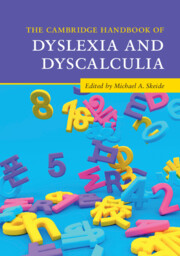Book contents
- The Cambridge Handbook of Dyslexia and Dyscalculia
- The Cambridge Handbook of Dyslexia and Dyscalculia
- Copyright page
- Contents
- Figures and Tables
- Contributors
- Acknowledgements
- General Introduction
- Part I Theoretical Frameworks and Computational Models
- Part II Cognitive Profiles and Behavioural Manifestations
- Part III Genetic and Environmental Influences
- Part IV Neurodevelopmental Foundations
- Part V Gender, Ethnicity, and Socioeconomic Background
- Part VI Cultural Unity and Diversity
- Part VII Early Prediction
- 17 Early Prediction of Learning Outcomes in Reading
- 18 Early Prediction of Learning Outcomes in Mathematics
- Summary: Early Prediction
- Part VIII Intervention and Compensation
- Part IX Best Practice – Diagnostics and Prevention
- Part X Best Practice – Schooling and Educational Policy
- General Summary
- References
- Index
Summary: Early Prediction
from Part VII - Early Prediction
Published online by Cambridge University Press: 28 July 2022
- The Cambridge Handbook of Dyslexia and Dyscalculia
- The Cambridge Handbook of Dyslexia and Dyscalculia
- Copyright page
- Contents
- Figures and Tables
- Contributors
- Acknowledgements
- General Introduction
- Part I Theoretical Frameworks and Computational Models
- Part II Cognitive Profiles and Behavioural Manifestations
- Part III Genetic and Environmental Influences
- Part IV Neurodevelopmental Foundations
- Part V Gender, Ethnicity, and Socioeconomic Background
- Part VI Cultural Unity and Diversity
- Part VII Early Prediction
- 17 Early Prediction of Learning Outcomes in Reading
- 18 Early Prediction of Learning Outcomes in Mathematics
- Summary: Early Prediction
- Part VIII Intervention and Compensation
- Part IX Best Practice – Diagnostics and Prevention
- Part X Best Practice – Schooling and Educational Policy
- General Summary
- References
- Index
Summary
(1) The ‘big three’ predictors of dyslexia in alphabetic learning contexts: Phonological awareness, letter knowledge, and rapid automatized (object and symbol) naming most strongly predict reading outcomes and dyslexia (explaining 40–60% of the behavioural variance). In scripts with transparent print-to-speech conversion, phonological awareness most strongly predicts reading outcomes during early stages of learning (but remains a reliable predictor in later grades for spelling).
- Type
- Chapter
- Information
- The Cambridge Handbook of Dyslexia and Dyscalculia , pp. 333 - 334Publisher: Cambridge University PressPrint publication year: 2022

